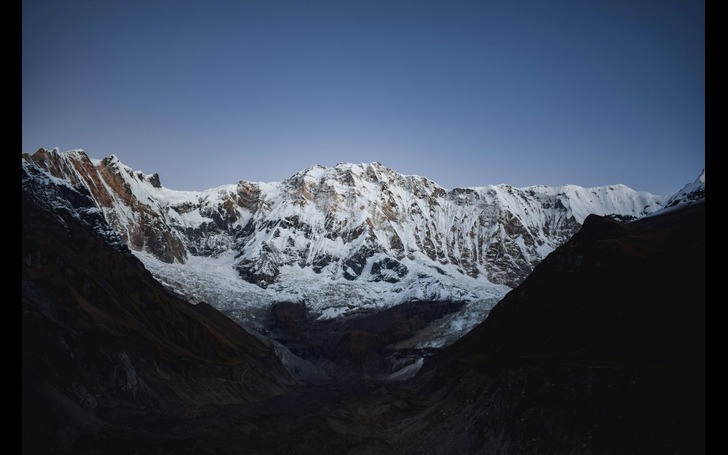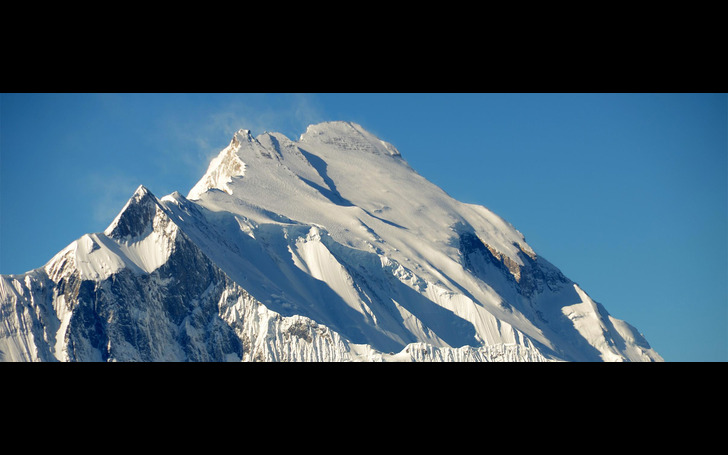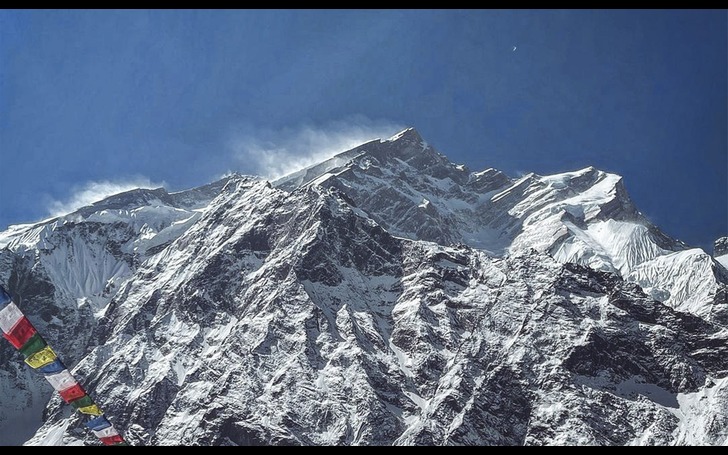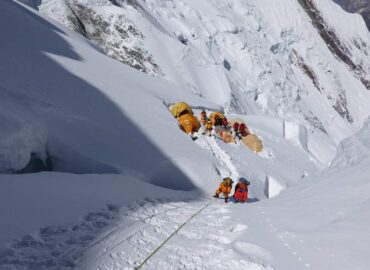- info@destinationholidaytrek.com
- +977-9768913779
- Gokarneshwor-6, Arubari, Kathmandu, Nepal
Annapurna I Expedition (8,091m)
| Destination: | Nepal |
| Maximum Altitude: | 8,091 meters |
| Best Season: | Spring, Autumn & Winter |
| Trip Grade: | Extreme Hard |
| Group Size: | 1 – 15 people |
| Duration: | 31 Days |
Annapurna I, standing at 8,091 meters (26,545 feet), is the tenth highest mountain in the world and the eighth highest in Nepal. More than just another 8,000-meter peak, it holds legendary status due to its notorious difficulty and historical significance. Known as one of the most formidable mountains to summit, Annapurna I challenges even the most seasoned climbers.
Located in the north-central Himalayas of Nepal, Annapurna I is part of the greater Annapurna Massif. It is flanked by Annapurna South to the south and Annapurna III to the west. To the east of the mountain lies the Kali Gandaki Gorge, the world’s deepest gorge, which separates Annapurna from the Dhaulagiri Massif, situated 34 kilometers to the west.
The Annapurna Massif consists of six major peaks, including Annapurna I (8,091m/26,545ft), Annapurna III (7,555m/24,786ft), Annapurna IV (7,525m/24,688ft), Gangapurna (7,455m/24,457ft), and Annapurna South (7,219m/23,684ft). This entire mountain range, along with its surrounding landscapes, is protected within the Annapurna Conservation Area, covering an expanse of 7,629 square kilometers (2,946 square miles). As Nepal’s first and largest conservation area, it is home to some of the world’s most renowned trekking routes, including the Annapurna Circuit.
Attempting an expedition to Annapurna I is a challenge that only highly skilled and experienced climbers should undertake. This climb requires meticulous logistical planning, extensive high-altitude mountaineering experience, and advanced technical climbing abilities. Proper acclimatization is crucial, along with the right equipment and an understanding of the risks posed by avalanches, landslides, and extreme weather conditions.
The South Face of Annapurna I is widely regarded as one of the most dangerous ascents in the world. Conquering this mountain demands immense physical and mental endurance, making it unsuitable for inexperienced climbers. Only those with exceptional skills, unwavering determination, and the ability to navigate life-threatening conditions should consider this ascent.
The standard route to the summit typically involves establishing three camps and following the West Face and Northwest Ridge, though climbers have used various other routes. The first successful ascent of Annapurna I was made on June 3, 1950, by a French expedition led by Maurice Herzog, alongside climber Louis Lachenal. Originally planning to summit Dhaulagiri, the team was forced to change course due to harsh conditions and limited resources. After weeks of intense struggle, they reached the top, making Annapurna I the first 8,000-meter peak ever successfully climbed. This record stood as the highest summit achievement on Earth for three years until Mount Everest was conquered.
Climbers considering an Annapurna I expedition should have extensive prior experience. Recommended prerequisites include summiting at least one 6,000-meter or 7,000-meter peak, multi-pitch climbing, or an 8,000-meter expedition. Suggested preparatory climbs include Lobuche East, Island Peak, Annapurna III, the Khumbu Three Peaks expedition, Mount Blanc, Baruntse, Annapurna IV, and Ama Dablam. Experience in multi-pitch rock or ice climbing, with a proficiency level of 6B to 7B+, is also highly recommended.
Why Annapurna I Expedition Is Famous?

Annapurna is regarded as one of the most technically demanding mountains in the world, infamous for its poor summit-to-fatality ratio. It has long held a reputation for its exceptionally high fatality rate and remains one of the least climbed 8,000-meter peaks. Due to its extreme difficulty and high-risk conditions, few climbers attempt Annapurna, and successful summits are rare.
More than just a towering peak, Annapurna is a breathtaking symbol of natural beauty, offering an unparalleled expedition experience. The combination of treacherous, steep terrain, unpredictable weather, and a high risk of avalanches makes the Annapurna Expedition one of the most challenging in the Himalayas and across the globe, despite its height of 8,091 meters. Climbing this mountain is an intense and demanding endeavor, ranking it among the most difficult 8,000-meter peaks in the world.
For those who seek the ultimate adventure, Annapurna offers an opportunity to push the boundaries of human endurance and determination. Every step toward the summit leads deeper into a world of raw natural beauty, testing both physical and mental strength. More than just a climb, this expedition is a journey into the heart of the Annapurna Himalayas, where every ascent tells a story of resilience and courage.
Summiting Annapurna I also provides a deeply immersive way to experience the stunning landscapes of western Nepal. The breathtaking views from the top extend across the Annapurna, Dhaulagiri, and Mansiri mountain ranges, making the grueling journey worthwhile. The South Face of Annapurna, one of the largest and steepest mountain faces in the world, adds to the challenge. However, new and safer routes are continuously being explored and developed, offering climbers improved options for ascent.
Beyond adventure, this expedition holds significant cultural importance for the people of Nepal. Named after a revered Hindu goddess, Mount Annapurna I is considered sacred. The route to the summit winds through diverse landscapes, showcasing the rich cultural and natural heritage of the Annapurna region.
Ultimately, the Annapurna I Expedition—first pioneered by Maurice Herzog and Louis Lachenal—embodies the spirit of exploration and the enduring allure of the Himalayas. It is a perfect fusion of adventure, culture, and spirituality, capturing the essence of mountaineering and the profound connection between humans and the mountains.
Annapurna I Expedition Overview

Annapurna I, standing at 8,091 meters, is the highest peak among the 30 summits of the 55-kilometer-long Annapurna massif and ranks as the tenth highest mountain in the world. This peak holds historical significance as the first 8,000-meter mountain to be successfully climbed. On June 3, 1950, Maurice Herzog led an expedition that reached the summit, achieving this feat three years before Tenzing Norgay and Edmund Hillary conquered Mount Everest.
Climbing Annapurna I is considered one of the most perilous mountaineering challenges. The mountain has a high risk of avalanches, and all ascent routes require navigating treacherous ice cliffs and seracs, making it one of the most dangerous 8,000-meter peaks.
Glaciers cover the western and northwestern slopes of the mountain, while the Kali Gandaki River has carved an immense gorge between the Annapurna and Dhaulagiri massifs. The expedition lasts a total of 40 days, with approximately 30 days dedicated to the climb from Annapurna North Base Camp to the summit and back. The remaining days involve trekking through the scenic Annapurna region.
The journey begins with a trek from Nayapul to Lete, following the Annapurna Circuit trail. Along the way, trekkers pass through scenic locations such as Ghorepani and Poon Hill. At Lete, the route diverges westward toward Annapurna North Base Camp, passing through Thulobugin, Hum Khola, and Miristi Khola. Above the base camp, two high-altitude camps will be set up to aid the summit attempt.
Standing atop the summit offers a sense of accomplishment and a breathtaking panoramic view of the Annapurna massif. After the successful ascent, climbers descend along the same route back to Tatopani. From there, a scenic drive takes them to Pokhara, followed by a flight to Kathmandu.
Accommodations in Kathmandu and Pokhara include comfortable hotels with bed and breakfast services. During the trek, full-board meals and lodging are available at teahouses, while tented camps provide shelter during the climb. The expedition is guided by certified and experienced mountaineering professionals, supported by a dedicated crew to ensure safety and efficiency.
Beyond the climb, participants can enjoy stunning views from Poon Hill, explore sections of the Annapurna Conservation Area, and visit traditional Gurung villages like Ghorepani. This experience offers insight into the region’s rich culture, traditions, hospitality, and diverse flora and fauna. The journey also includes time to explore Pokhara, a city famous for its serene lakes and breathtaking landscapes.
The best seasons to undertake this expedition are spring and autumn, as these periods offer the most stable weather conditions for trekking and climbing.
Best Time to Climb Annapurna I

The most favorable season for climbing Annapurna I is **spring (March to May)**. During this time, the weather remains stable, ensuring safer climbing conditions. Temperatures are more manageable, reducing the risks associated with extreme cold and unpredictable storms. Clear skies enhance visibility, allowing for better navigation and breathtaking views. These ideal conditions make spring the best window for a successful and less hazardous ascent.
Included
- Airport/Hotel/airport transfers
- 4 nights’ accommodation in Kathmandu and 2night star hotel in pokhara with breakfast
- Fly from Kathmandu – pokhara – Kathmandu and all your luggage to Annapurna Base Camp and back to Kathmandu
- Expedition Government Royalty
- All camping facilities and meals during the expedition including a tent (one member = one tent) at Base camp.
- Kitchen and Dining equipment, Eating utensils, Shower Tents, Toilet Tent, Store Tent, etc
- All porter and helicopter cost wages from Kathmandu to base camp Base camp and back to Kathmandu
- All costs for support staff (guide, cook, kitchen helpers, and porters)
- Liaison officer, his fee, daily wages, equipment, clothing, accommodation, flight, meals, and insurance
- All our base camp staffs, porters, Climbing Sherpas, insurance, and their daily wages, and their equipment allowance.
- All breakfast, Lunch, Dinner, Tea, Coffee from during the trekking and Base Camp and till back to Kathmandu.
- Generator and Solar Panel at Base Camp
- Experience climbing Guide and Base Camp Manager, his daily wages, insurance, equipment allowance, meals, accommodation etc
- Climbing Rope Fixing fee for Expedition operators Association of Nepal
- Satellite phone for Emergency use
- Necessary oxyzen and mask regulator
- Breakfast, Lunch, Dinner, Tea, Coffee, Hot water for shower at Annapurna base camp
- Three time meal and tea, coffee during the trekking and expedition
Excluded
- International flights and airport taxes.
- Visa fees.
- Bar bills and laundry.
- Travel insurance.
- Lunch and evening meals in Kathmandu.
- Tips for driver, guide, porter, BC staff and climbing Sherpas
- Successful Climbing Bonus for the Sherpa – (USD 1500 recommended)
Annapurna I Expedition Itinerary
Itinerary to Annapurna I Expedition as follows:
Day 01: Arrival in Kathmandu and Hotel Transfer
Upon arriving in Kathmandu, the Annapurna I Expedition team will greet you and escort you to your hotel. This marks the official start of your Mt. Annapurna I adventure. Take this time to relax and recover from your journey, preparing for the challenges ahead.
The following day, you will attend a mandatory briefing at the Ministry of Tourism, where essential details about the climb will be discussed. This session is crucial for ensuring you are well-prepared and fully informed before embarking on the expedition.
– Accommodation: The Everest Hotel
– Meals: Not Included
Day 02: Expedition Preparation and Hotel Stay
This day is dedicated to finalizing preparations for the Mt. Annapurna I Expedition. Take the time to inspect, organize, and fine-tune your gear, ensuring everything is in top condition for the demanding journey ahead. If needed, you can make last-minute purchases or adjustments to optimize your equipment for the challenges you will encounter.
Thorough preparation is essential for a smooth and safe expedition. This day allows you to carefully organize all necessary gear, fostering confidence and readiness before setting off on this extraordinary adventure.
– Accommodation: The Everest Hotel
– Meals: Breakfast
Day 03: Expedition Briefing at the Ministry of Tourism and Hotel Stay
Today is a crucial step in your Mt. Annapurna I Expedition as you attend a mandatory briefing at the Ministry of Tourism. This session provides essential information about the expedition and ensures you receive the necessary permits required for the climb. These documents are vital for a smooth and legally compliant journey.
Attending this briefing is a key part of your preparation, equipping you with the knowledge and authorization needed to navigate the challenges of the expedition. With all formalities completed, you will be one step closer to embarking on this extraordinary adventure.
– Accommodation: The Everest Hotel
– Meals: Breakfast
Day 04: Drive to Beni via Pokhara by Private Bus
Leaving Kathmandu, the journey begins with a scenic drive towards the beautiful city of Pokhara. As you travel through Nepal’s diverse landscapes, you will witness lush hills, winding rivers, and glimpses of the towering Himalayas. Upon reaching Pokhara, the tranquil lakes and breathtaking mountain views create a mesmerizing backdrop before continuing the drive toward Beni.
Beni, a charming town rich in culture and natural beauty, serves as the gateway to your Annapurna I Expedition. A comfortable stay at a local lodge allows you to rest and immerse yourself in the warmth of Nepalese hospitality. This peaceful stop offers a moment of relaxation before the adventure intensifies.
– Accommodation: Local Lodge
– Meals: Breakfast, Lunch, Dinner
Day 05: Drive to Lete, Lodge Accommodation
After a nourishing breakfast, the journey continues with a scenic drive toward Lete. This route offers breathtaking views of Nepal’s diverse landscapes, from lush forests to towering peaks. As you travel along winding mountain roads, the natural beauty of the region enhances the excitement of the expedition.
Upon arriving in Lete, a serene village surrounded by majestic mountains, you will settle into a comfortable lodge for the night. This cozy accommodation provides a perfect setting to rest and recharge after the day’s travel. It also offers an opportunity to experience local culture and hospitality, setting the stage for the adventures ahead on the Annapurna I Expedition.
– Accommodation: Local Lodge
– Meals: Breakfast, Lunch, Dinner
Day 06: Trek to Jungle Camp, Camping
The expedition progresses as you embark on a trek toward Jungle Camp, immersing yourself in the untouched wilderness of the Annapurna region. This journey takes you through lush forests, rugged trails, and diverse landscapes, offering a serene escape into nature. The peaceful surroundings and breathtaking scenery make this part of the trek an unforgettable experience.
Upon reaching Jungle Camp, you will set up camp for the night in a remote and tranquil setting. Under a vast, starlit sky, the campsite offers a perfect retreat to embrace the beauty of the outdoors. This night in the wilderness allows you to disconnect from the modern world and fully appreciate the raw and untamed nature surrounding you, preparing you for the challenges ahead in the Annapurna I Expedition.
– Accommodation: Tented Camp
– Meals: Breakfast, Lunch, Dinner
Day 07: Trek to Miristi Khola, Camping
The journey continues as you trek toward Miristi Khola, venturing deeper into the remote wilderness of the Annapurna region. This section of the expedition offers an immersive experience of the pristine landscapes, where the untouched beauty of nature unfolds with every step. Towering peaks, rugged terrain, and the soothing sound of flowing water create an awe-inspiring atmosphere, strengthening your connection to the natural world.
Upon reaching Miristi Khola, a well-prepared campsite awaits, ensuring a comfortable and secure overnight stay. In this tranquil environment, you can unwind and absorb the serenity of your surroundings. The stillness of the wilderness, combined with breathtaking mountain views, makes this night a special part of your Annapurna I Expedition, allowing you to recharge before the challenges ahead.
– Accommodation: Tented Camp
– Meals: Breakfast, Lunch, Dinner
Day 08: Trek to Annapurna West/South, Camping
Today’s trek takes you to Annapurna West/South, a crucial phase in your Annapurna I Expedition. This site will serve as your base camp, where you will prepare for the challenging ascent ahead. As you gradually gain altitude, your body begins the essential process of acclimatization, adapting to the thinner air and harsher conditions of the Himalayas. This adjustment is key to ensuring a safer and more successful climb.
Upon arrival at Annapurna West/South, you’ll settle into a well-prepared campsite designed to offer comfort and security at high altitudes. Here, you will have time to finalize your preparations, check equipment, and mentally and physically gear up for the upcoming ascent. This marks a defining moment in the expedition, as you stand on the threshold of one of the world’s most formidable climbs.
– Accommodation: Tented Camp
– Meals: Breakfast, Lunch, Dinner
Day 09-38: Climbing Period of Annapurna I (8091m), Camping
The next 30 days represent the core of the Mt Annapurna I Expedition, focusing on the challenging and exhilarating ascent of Annapurna I, which rises to 8,091 meters. During this crucial phase, camping will serve as your base, as you work relentlessly towards the ultimate goal of reaching the summit and achieving the primary objective of your expedition.
Conquering the summit of Annapurna I is no small feat. It requires not only physical strength but also immense mental resilience and technical expertise in high-altitude mountaineering. As you climb higher, the obstacles intensify, including navigating treacherous ice and rock formations, dealing with avalanche-prone slopes, and enduring the intense cold at these extreme altitudes.
Each step forward is a victory, a testament to your ability to endure the ever-decreasing oxygen levels and the harsh environment. The guides and expedition team play a vital role in your safety and progress, offering expert advice, support, and motivation as you push through every challenge.
This phase is demanding yet incredibly rewarding. The climb to the summit of Annapurna I is a transformative experience that tests the limits of human capability. Standing at the summit offers an unmatched sense of accomplishment and reveals a stunning panoramic view of the Himalayan range, making every moment of struggle worthwhile.
However, the journey doesn’t end at the summit. The descent is equally rigorous, requiring careful attention and precision. Safety remains a top priority, as you make your way back down the mountain.
This period of the expedition embodies the essence of high-altitude mountaineering, where the spirit of perseverance meets the awe-inspiring power of the Himalayas in an unforgettable adventure.
– Accommodation: Tented Camp
– Meals: Breakfast, Lunch, Dinner
Day 39: Trek to Miristi Khola, Camping
After the exhilarating yet demanding climbing period of the Mt Annapurna I Expedition, your journey takes a turn as you descend back to Miristi Khola. This peaceful location offers a serene environment to rest and recover after the intense climb.
Arriving at Miristi Khola, you’ll find comfortable camping accommodations set up to welcome you. This return to lower altitudes provides an essential opportunity to recuperate, reflect on the triumphs of your summit ascent, and unwind in the tranquility of the natural surroundings.
Camping at Miristi Khola allows you to relax and immerse yourself in the peaceful atmosphere, offering a moment to connect with your fellow adventurers and share stories of the expedition’s highs and lows. It’s a fitting way to close this chapter of the Annapurna First Expedition as you prepare for the remaining stages of the journey.
– Accommodation: Tented Camp
– Meals: Breakfast, Lunch, Dinner
Day 40: Trek to Jungle Camp, Camping
Today, you’ll begin your descent from Miristi Khola and retrace your steps back to Jungle Camp. This leg of the journey offers a chance to revisit the pristine wilderness, soaking in the captivating beauty of the surroundings as you make your way back.
At Jungle Camp, you’ll once again immerse yourself in the tranquility of nature, with the sounds of the forest and a starlit sky offering a peaceful backdrop. This is a moment to reflect on the challenges and triumphs of the expedition, taking time to recharge and reconnect with the simplicity of outdoor life.
This night at Jungle Camp serves as a fitting pause in your journey, allowing you to embrace the outdoors and continue your trek through the Annapurna First Expedition with renewed energy.
– Accommodation: Tented Camp
– Meals: Breakfast, Lunch, Dinner
Day 41: Trek to Lete, Lodge Accommodation
Your journey continues with a trek back to Lete, where the path unfolds with mesmerizing landscapes and the serenity of the Nepalese countryside. As you trek, you’ll be treated to stunning views of the region’s natural beauty, allowing you to savor the peace and tranquility that defines this part of the Annapurna First Expedition.
Upon reaching Lete, you’ll be welcomed into a comfortable lodge, where you can rest and rejuvenate in a peaceful environment. This stop offers an opportunity to unwind, soak in the local culture, and reflect on the journey so far, all while preparing for the next stages of your adventure.
– Accommodation: Local Lodge
– Meals: Breakfast, Lunch, Dinner
Day 42: Drive to Beni and then Pokhara. Transfer to the Hotel
Today marks a transition as you drive from Beni to Pokhara. This scenic drive offers you one last chance to enjoy the beautiful landscapes of Nepal. Upon arriving in Pokhara, our team will smoothly transfer you to your hotel, where you can unwind after the thrilling adventure.
In Pokhara, you’ll find tranquility amidst the stunning backdrop of the Annapurna Range and the serene Phewa Lake. This is your opportunity to reflect on the remarkable Annapurna First Expedition, relax, and share stories with fellow adventurers, celebrating the success of your journey.
– Accommodation: Hotel
– Meals: Breakfast, Lunch, Dinner
Day 43: Drive or Fly Back to Kathmandu, Hotel Accommodation
As your Annapurna First Expedition draws to a close, you have the option to either drive or fly back to Kathmandu, depending on your preference. Regardless of your choice, our team will ensure a smooth and comfortable transfer to your hotel in Kathmandu, where you can unwind after the adventure of a lifetime.
In Kathmandu, take time to reflect on the incredible journey you’ve just completed, sharing experiences with fellow adventurers. Immerse yourself in the vibrant culture of the city, soaking in the rich history and traditions that Nepal’s capital has to offer. This final day provides the perfect moment to relax and appreciate the balance of adventure and cultural discovery that has defined your Annapurna First Expedition.
– Accommodation: The Everest Hotel
– Meals: Breakfast
Day 44: Free Day in Kathmandu, Hotel Accommodation
Your final day in Kathmandu is a free day, giving you the chance to enjoy the city at your own pace. Whether you choose to explore the bustling streets, shop for unique souvenirs, or simply relax at your hotel, this is your time to unwind and take in the vibrant atmosphere of Kathmandu.
In the evening, a special farewell dinner awaits, complete with an entertaining cultural program. It’s a delightful way to celebrate the conclusion of your Annapurna First Expedition, where you can savor delicious local dishes, experience Nepalese traditions, and reflect on the friendships and memories created throughout this unforgettable journey.
– Accommodation: The Everest Hotel
– Meals: Breakfast and Dinner
Day 45: Final Departure
Your Annapurna Expedition, a thrilling adventure through the Nepalese Himalayas, reaches its conclusion today. Our team will assist in your smooth transfer to Kathmandu airport, signaling the end of this extraordinary journey. As you depart from Nepal, the breathtaking landscapes, the challenges you overcame, and the friendships you forged will stay with you forever.
At the airport, you’ll reflect on your incredible achievements and express gratitude for the experiences you’ve had. The Mt Annapurna 1 Expedition will forever be a cherished memory, a testament to your perseverance and the unmatched beauty of the Himalayas.
– Meal: Breakfast
View On Map
Photo Gallery



